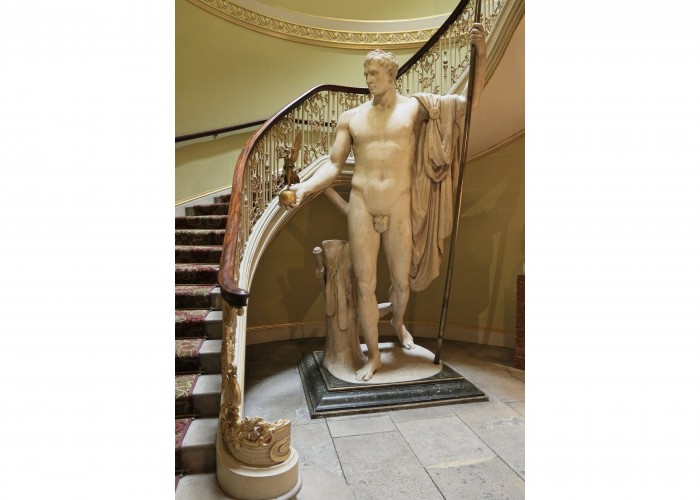Napoleon as Mars the Peacemaker, Canova
This huge, 3.45 metres tall marble statue depicts the head of the French Emperor Napoleon on the body of the Roman god Mars. It was commissioned in 1802, long before the French defeat at the Battle of Waterloo, when Napoleon was 33 years old and First Consul of France. He summoned the most famous sculptor in the world, the Italian Antonio Canova, to Paris and chose him to create a propagandistic statue.
In March 1802, after 9 years of fighting the French Revolutionary Wars, France and Britain signed the Treaty of Amiens, temporarily ending hostilities – the only break in the fighting before the Battle of Waterloo. This peace barely lasted a year, but Napoleon was still keen to portray himself as a peacemaker. Napoleon was skilled at propaganda and wanted his image to appear in various media to enhance his prestige. For this purpose he employed Canova, renowned at the time as the finest sculptor in Europe.
It took Canova four years to carve the figure, after Napoleon gave him a record number of five sittings. The statue was not transported to France for some years and Napoleon saw it for the first time in April 1811 just before its public exhibition in the Musée Napoleon (now the Louvre). Mars/Napoleon is portrayed as a tall, perfectly proportioned hero. He is naked rather than in armour. Instead of weapons of war he carries a gilded figure of Nike (Greek goddess of Victory) on an orb in his right hand and a staff in his left. A sword and belt are draped on the tree stump at his side. Mars, the Roman god of war, is depicted as having brought peace and now having put aside his arms and armour.
Unfortunately, the statue bore no resemblance to the shorter, now portly figure of Napoleon who immediately took against it. Probably afraid that people would ridicule the contrast between himself and the statue, he criticised it as “too athletic” and ordered it to be removed from the public gaze.
The statue remained in storage until 1816, after Waterloo and Napoleon’s fall. It was sold by the new French monarchy to the British government for 66,000 francs (worth perhaps £191,000 in today’s money). It was presented to the Duke of Wellington, who gave it pride of place in the stairwell of his house. The floor had to be strengthened to carry its weight. There is no record of what Wellington thought of the statue but his guests showed scant respect when they hooked their umbrellas on it.
Some years later an even larger nude bronze statue was made by the famous sculptor, Sir Richard Westmacott, who had studied under Canova. It celebrated the Duke of Wellington, and depicted Achilles, the Greek hero of the Trojan wars. The naked statue was greeted with derision. It had been commissioned by a group of upper-class ladies who were so outraged by its nudity that Westmacott was forced to cover the offensive part with a fig leaf. The statue still stands in Hyde Park, though few people realise it commemorates Wellington as a war hero.
-
Curatorial info
- Originating Museum: Apsley House
- Production Date: 1806
- Creator: Antonio Canova
- Material: Marble
- Size: 345 cm
-
Use this image
You can download and use the high resolution image for use in a non-profit environment such as a school or college, but please take note of the license type and rights holder information below
- Rights Holder: Photograph public domain
- License Type: Open Government
Find it here
This object is in the collection of Apsley House – English Heritage






